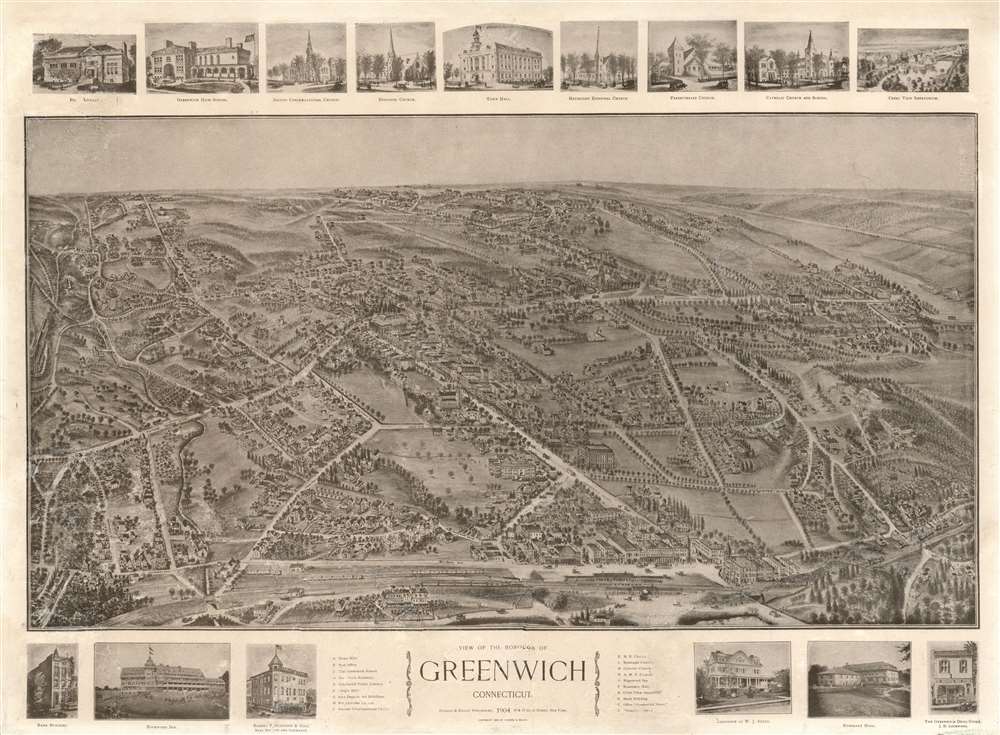This item has been sold, but you can get on the Waitlist to be notified if another example becomes available, or purchase a digital scan.
1904 Hughes and Bailey View of Greenwich, Connecticut
Greenwich-bailey-1904
Title
1904 (dated) 16.75 x 23 in (42.545 x 58.42 cm)
Description
Landmark Views
As is traditional with such views as this, the map is bordered at top and bottom with an array of fifteen architectural views. While most of these are reproduced from drawings, at least three are plainly sourced from photographs of their subjects: Edgewood Inn, the residence of W. J. Smith, and Rosemary Hall.Hughes and Bailey Views
In 1904, Bailey was in his early 60s. At an age when most men would be looking toward retirement, the Bailey entered into a new business, partnering with the younger Thomas S. Hughes. Under the imprint of 'Hughes and Bailey', the duo traveled throughout New York and New England, revisiting the sites of Bailey's earlier views. In each, they painstakingly made new views, what they called 'aero-views' from the same perspective point of the earlier view, but 20 - 40 years later. Most were artistic renderings, like the earlier views, but some incorporated photography. These were then printed using half-tone copper plate process - considerably cheaper than the older stone lithographs. The marketing angle, evident in numerous newspaper advertisements from 1904 to 1926, was to set the old and new side by side thus illustrating change and growth. They worked together on these views, as is described in an article appearing in the March 29, 1912 issue of the Norwich Bulletin,It has taken the artists eight months of hard and faithful work to go through the streets and sketch each building separately. They did most of their work during the summer months. It is quite amusing to hear them relate some of their experiences, having been mistaken for burglars, prospective real estate promoters and curiosity seekers.Hughes and Bailey remained partners for over 20 years, pushing Bailey well into his 80s - nothing to the vigorous man who lived to 104.
Publication History and Census
This view was drawn by Oakley Hoopes Bailey and Thomas S. Hughes, and published under the imprint of 'Hughes and Bailey'. This view is extremely rare: we are aware of no other examples having surfaced on the market, there are no examples in OCLC, and the Library of Congress - which has a large number of Hughes and Bailey prints - does not have this view in their collection. The only surviving example.CartographerS
Oakley Hoopes Bailey (June 14, 1843 - August 13, 1947) was a prolific American viewmaker, artist, and lithographer active in late 19th and early 20th century. Bailey was born in Beloit, Mahoning County, Ohio. He matriculated in 1861 at Mount Union College in Alliance, Ohio, where he studied architecture. At the outbreak of the American Civil War (1861 - 1865) he briefly abandoned his studies for 2 years, wherein he saw combat as a Union solider. After the war, in 1866, he returned to Mount Union to complete his degree. Bailey was the younger brother of another view artist, Howard Heston Bailey (1836 - 1878) and followed his brother into the print business, producing his first city views, of Milwaukee, Wisconsin, in 1871. Active from 1871 to 1926, Bailey is known for more than 375 recorded city views, covering more than 13 states 2 Canadian provinces, making him one of the most active viewmakers in American history. In 1875, he settled in Cambridge, Massachusetts and most of his subsequent work focused on Massachusetts and Connecticut. Bailey worked with many other American viewmakers of the period, including his brother, Howard Heston Bailey, Thaddeus M. Flower, and J. C. Hazen, among others. Even his wife, Sarah F. Bailey (1846 - 19??) got into the business, drawing at least one view, of Watkins Glen, New York. Around 1904, by this time in his 60s, Bailey entered into a publishing partnership with Thomas S. Hughes, publishing their 'aero-views' as 'Hughes and Bailey'. Together, Hughes and Bailey revisited the sites of many of Bailey's early views, remaking them sometimes 20 - 40 years later, the idea being to set them beside the earlier views to show how much the respective towns had changed. The partnership lasted until about 1926. Bailey died in his hometown of Alliance at the ripe old age of 103. More by this mapmaker...
Thomas S. Hughes (fl. 1904 - 1926) was an American viewmaker active in the early years of the 20th century. Hughes is an elusive figure before and after his viewmaking career - due in part to the commonality of his name. In 1904 Hughes partnered with the venerable Oakley Hoopes Bailey (1843 - 1947), who was then in his 60s. The duo traveled throughout New York, New Jersey, and New England, revisiting the sites where 20-40 years earlier, Bailey made his own views. There they made new views, illustrating the development and change that occurred over the intervening period. The 'Hughes and Bailey' Aero-Views as they were known are universally copper half-tone images - suggesting that Hughes implemented modern photo-mechanical printing technology and even photography to enhance the viewmaking process and printing. Hughes appears to have moved around a lot. When the partnership was founded, he was living in Brooklyn. His wife died in that year, shortly after the firm was founded. By 1912, he is noted has having relocated to Cambridge, Boston. The last Hughes and Bailey view appears in 1926. After this time, there is no verifiable record of Hughes. Learn More...

